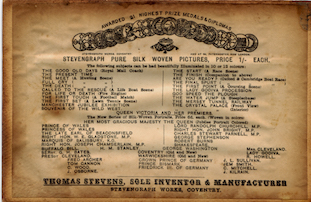
LONDON – Every married man knows the story of Lady Godiva. Leofric (968-1057), the Earl of Mercia, had a nagging wife too, although in fairness, she wanted him to take pity on the people of Coventry and stop taxing them so harshly.
In the end, he tried to silence her by challenging her to ride through the streets in the buff. If she did so, he would relent. Ever the clever one – aren’t they always – she did just that, having first commanded everyone to stay indoors and close their curtains, hiding her modesty behind her long hair.
Apart from the knights who accompanied her, only one other man saw her: a tailor named Tom, which is where the expression Peeping Tom is said to originate.
Fittingly, a picture of her ride was made by Coventry woven silk manufacturer Thomas Stevens (1828-1888) whose idea of producing them saved his entire workforce from poverty. Over the years until about 1938 literally hundreds of the so-called Stevengraphs were produced, featuring every subject imaginable.

Fancy silk ribbon weaving began in Coventry in about 1700. However, when the French invented the Jacquard loom in 1801, it was they who led the way in mass-production of silk woven designs.
The Jacquard produced mile after mile of ribbon to patterns reproduced on punched cards fed automatically through the loom. The machines were adopted by Coventry manufacturers and by 1840 half the city’s workforce was employed in the industry.
Thomas Stevens went into the business straight from school and established his own silk mill in 1854. However, in 1860, the British government agreed to an Anglo-French free trade treaty that removed duty on imported silk, brocade and ribbons. Cheap foreign goods flooded the home market.
Coventry was one of the victims with mill closures and mass unemployment. Looms were left idle and in a two-year period alone, some 9,000 weavers left to find alternative work.
Entrepreneur Stevens saw opportunity in the downturn. He had been experimenting with the Jacquard looms and hit on the simple idea of adapting them to produce vertical rather than horizontal designs.
A series of inventive alterations allowed the production of silk pieces in multiple colors with exquisite detail and a seemingly three-dimensional effect. When cut into short lengths and finished with silk tassels, the resulting woven silks made charming bookmarks.
Three years after the slump, Stevens had created a new market and his woven bookmarks, which he called by the patented name of Stevengraphs, were selling like hotcakes. The continued livelihood of his family and his loyal workforce was assured.

Instead of supplying the drapery trade, Stevens persuaded booksellers and stationers to sell his bookmarks. The eye-catching and colorful creations depicting illuminated texts from the Bible, poems, Christmas, New Year, birthday and Valentine’s Day greetings, portraits of royalty, and contemporary scenes proved hugely popular.
Stevens subsequently claimed to have produced 900 different bookmark designs for the home market, the Continent and the United States, although only about half that number has been cataloged by current research.
Encouraged by his early success, in 1879 Stevens introduced mass-produced woven silk pictures, which he fitted in simple cardboard mounts so they would last longer.
They were introduced at the little-known York Exhibition, which opened on May 7 that year. Centerpiece of the exhibition was a stand with two Stevens looms operating throughout the duration producing scenes of local interest: the London and York Stage Coach and Dick Turpin’s Ride to York, all produced before the eyes of eager buyers.
Their striking almost three-dimensional effect impressed visitors who were able to buy them straight from the loom for a shilling (5p) each.

New pictures were issued at the rate of one a month and at least 70 different topics are covered including portraits of royalty, sporting, military, religious and political figures; exhibitions, castles and well-known buildings; horse racing; coursing and fox hunting; sports; battleships and even fire engines. Some are surprisingly rare, others relatively common, with prices to match.
They were exhibited in America, France and Holland, and won some 30 medals and diplomas at trade shows exhibitions.
Stevens died in 1888, but the factory continued to be run by his two sons until it was made a limited company in 1908. Sadly, however, fashions were changing and by about 1914, demand for Stevengraphs dwindled.
The portraits of King George VI and Queen Elizabeth the Queen Mother produced in 1938 were probably the last to be made before the factory was destroyed in the Coventry Blitz of 1940.
The hallmarks of a good collectible Stevengraph are brightly colored silks, with an unstained and original card mount. Their enemies are strong sunlight, which will bleach out the color; dampness, which will cause the colors to stain or run and card mounts that become brittle with age.
Avoid faded examples or those with dirty or damaged mounts. They are impossible to restore and values can be affected seriously. Bookmarks change hands at between £5 to £50, depending on their size and how elaborate they are.
Mounted pictures can be eight or 10 times that amount depending on condition, rarity and subject. Pious or religious scenes are least desirable and therefore cheapest. Queen Victoria is worth more than Gladstone, for example, but much less than cricketer W.G. Grace.
by Christopher Proudlove





